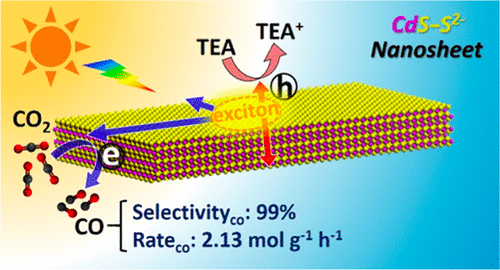Prof. Doh Chang Lee’s group at KAIST has developed two-dimensional (2D) CdS nanosheets of atomically-precise thickness that convert CO2 to CO with record-breaking performance. By spatially separating the redox catalytic sites to designated surface facets, this novel CdS nanosheet photocatalyst addresses longstanding charge separation issues that hinder the activity of nanostructured photocatalysts. The facet-dependent redox active sites efficiently promote the balanced extraction of photogenerated electrons and holes, leading to an approximately 100-times improvement in activity compared to previous nanostructured photocatalysts. This study was published on 25 August 2022 (Efficient, Selective CO2 Photoreduction Enabled by Facet-Resolved Redox-Active Sites on Colloidal CdS Nanosheets J. Am. Chem. Soc. 2022, 144, 37, 16974–16983) and was selected as a cover paper in JACS.
“We set out to develop photocatalysts that can help to solve global warming and energy shortage issues by efficiently converting the main greenhouse gas into chemical fuels using sunlight” said Nianfang Wang, the first author of the paper and a Ph.D. student under Prof. Doh Chang Lee’s supervision in the Department of Chemical and Biomolecular Engineering and the Energy and Environmental Research Center at KAIST.
Photocatalytic reduction of CO2 to fuels using renewable solar energy as a driving force is an essential solution to alleviate global warming and the energy shortage crisis. Advances in nanotechnology have enabled precise design of catalytic sites for CO2 photoreduction, pushing product selectivity to near-unity. However, activity of most nanostructured photocatalysts remains underwhelming, due to fast recombination of photogenerated electron-hole pairs and sluggish hole transfer.
To address these issues, Professor Lee’s research team designed 2D colloidal CdS nanosheets with the large basal planes terminated by S2- atomic layers as intrinsic photocatalysts (CdS–S2- NSs). Surface engineering with S2- termination endows the ultrathin photocatalysts with facet-resolved redox-catalytic sites: oxidation occurs on S2--terminated large basal facets and reduction happens on side facets. Such an allocation of redox sites minimizes the hole-diffusion (slow) length within a few atomic layers, maximizes the oxidation sites that consume holes, and spatially separates the electrons (fast) towards reduction sites at the lateral edges of the sheet.
Consequently, CdS–S2- nanosheets exhibit a record-breaking performance for photocatalytic CO2-to-CO conversion: a CO selectivity of 99%, a CO formation rate of 2.13 mol g–1 h–1, and an effective apparent quantum efficiency of 42.1% under irradiation (340 to 450 nm) of a solar simulator (AM 1.5G).
Wang said, “This work not only reports a class of excellent photocatalysts for large-scale solar-driven CO2 reduction application, but also provides insight on how to design photocatalysts for other reactions (such as H2 evolution or N2 fixation).”
This work was supported by the Saudi Aramco-KAIST CO2 Management Center.

Prof. Doh Chang Lee, Nianfang Wang
Dept. of Chemical and Biomolecular Engineering
KAIST Energy and Environmental Research Center, KAIST
KAIST Institute for the NanoCentury (KINC)
Saudi Aramco-KAIST CO2 Management Center
Homepage: http://dclee.kaist.ac.kr
E-mail: dclee@kaist.edu






